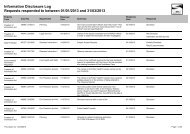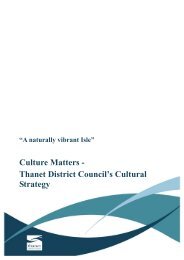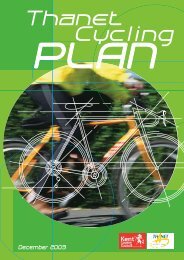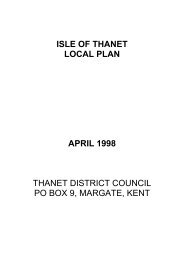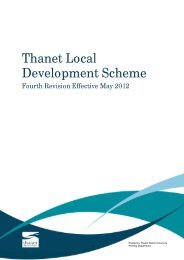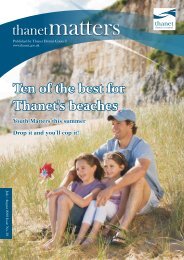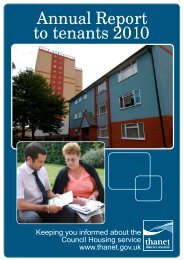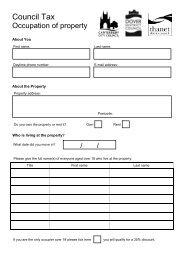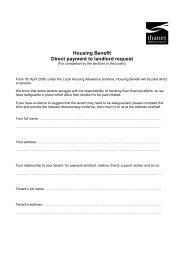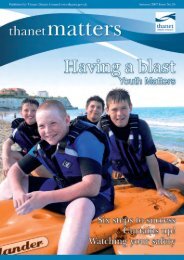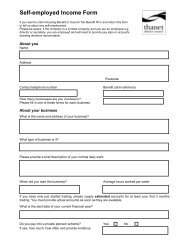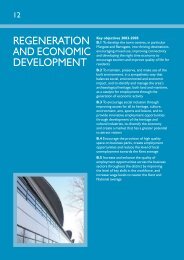Review of existing Section 106 Agreement - Thanet District Council
Review of existing Section 106 Agreement - Thanet District Council
Review of existing Section 106 Agreement - Thanet District Council
You also want an ePaper? Increase the reach of your titles
YUMPU automatically turns print PDFs into web optimized ePapers that Google loves.
Each aircraft type and subtype has therefore a recognised and formallycertified noise pr<strong>of</strong>ile, which can be used in establishing noise monitoringprocedure, and in modelling forecast noise in the future from forecast aircraftmovement schedules. For certification purposes the noise measurement usedis the Effective Perceived Noise Level measured in ENPdB which isanalogous to dBA.Chapter 1 aircraft disappeared from the fleets <strong>of</strong> world airlines in the 1970’sand 80’s, and in the US, Europe and most developed countries Chapter 2aircraft were phased out by 2003, leaving only the much quieter Chapter 3aircraft operating in these countries. In certain parts <strong>of</strong> the world such asEastern Europe, Africa, South America and China some earlier Chapter 2aircraft are still used. The Annex 16 Chapter criteria represent a range <strong>of</strong>aircraft noise, so that the perceived difference between the quietest Chapter 2and the loudest Chapter 3 aircraft can be small. With continuing advances inaircraft engine technology the international bodies are currently in the earlystage <strong>of</strong> identifying whether, and when, a future Chapter 4 Standard can bepractically introduced.3.4 Noise measurement at airportsThe most commonly used measures <strong>of</strong> aircraft noise at airports are subdividedbetween :• Single Event Measures associated with a single aircraft movement• Cumulative Measures which seek to represent over time thecumulative effects <strong>of</strong> many movements over a specified period. Thecalculation <strong>of</strong> these involves the accumulation <strong>of</strong> the magnitude <strong>of</strong>each individual noise event due to a take<strong>of</strong>f or landing, and the totalnumber <strong>of</strong> such events in the measurement period. In the UK thedaytime cumulative measure is generally taken over a 16 hour day(07.00 to 23.00 hours) and is expressed as the LAeq(16hour) in dBA.The cumulative measure represents the “average noise level” over theperiod, but in this form cannot differentiate between, say, a single veryintensive and disturbing noise event and numerous moderate noiselevels occurring during the same measurement period.3.5 Airport noise contoursNoise contours are a measure <strong>of</strong> average noise exposure represented on theground as a series <strong>of</strong> lines <strong>of</strong> equal exposure. The cumulative LAeq is usedas a basis for the calculation <strong>of</strong> noise contours in the vicinity <strong>of</strong> an airport, andcan be calculated based on schedules and noise readings experienced over adefined period, giving an historical noise contour. Alternatively noise contoursfor future years, based on an airport’s development plans and traffic forecastscan be calculated using a combination <strong>of</strong> forecast schedules by expectedaircraft type and each individual aircraft noise characteristics from the formalnoise certification process. A number <strong>of</strong> specialist programs to producecontours are available from noise advisers.In calculating the contour for, say, a particular year it is normal practice tomodel the peak summer period <strong>of</strong> airport operations, the resulting contour thusEU00142:FINAL REPORT PAGE 10



